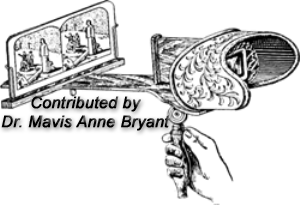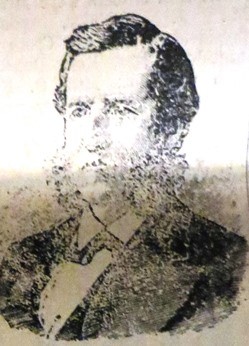
William B. Boss
William B. Boss was born in
1832 in Baltimore,
Maryland. After high school he went to work in merchandising for
several years,
then turned his attention to railroading. In September 1872, the year
that
Denison was established, he established a firm known as Boss, Pinto and
Jennings. As head of the firm, he engaged in the lumber and
agricultural
implement business and the building of the Lone Star Flour Mill where he became superintendent.
The Denison Daily News
February 25, 1873
Monday
evening the citizens of Denison congregated at the foot of Owings
Street to witness the laying of the corner stone of the magnificent
Flouring Mill now in course of erection by the Proprietors, Messrs.
Boss, Jennings & Co.
At the unanimous request of the vast
concourse of people there assembled, Mr. J.W. Jennings acted as master
of ceremonies, and in a few brief remarks explained the nature of the
occasion which had brought the assembly together, after which the
workmen proceeded to lay the northeast corner stone of what is to be
the most expensive building yet projected in Denison.
The ceremony
of placing the stone in position having been performed, the blessings
of Deity were invoked on the proprietors, the workmen and the building.
Many were the congratulations the inaugurators of this great
enterprise received.
The following articles were sealed up in a canister and placed under the corner stone: a copy of the first number of the Daily News, a copy of the Weekly News, and also a copy of the Journal,
a time card and freight tariff of the M.K. & T Ry., one of Boss,
Pinto & Jennings's business cards, a postage stamp, a nickel, each
denomination of fractional currency, and a letter of dedication; also a
small vial of the fluid extract of corn.
The mill which has received
the name of "The Lone Star Mill of Denison", in honor of the great
State in which it is located, is to be built of the excellent brown
sand stone obtained in the vicinity of Denison, and consists of three
stories besides the basement, with a mansard roof.
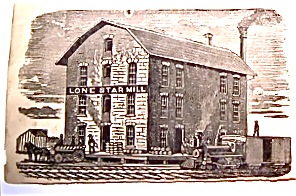
The
mill work will be put up under the direction of Superintendent David
Langton, who is also to be the miller and will be a partner in the mill.
The
capacity of the mill will be 200 barrels of flour per day (requiring
1,000 bushels of wheat), and 400 barrels of corn meal. The best
brand of flour will be known as the Lone Star brand.
Thus has been
inaugurated a work of which every good citizen of our young and
thriving city may justly be proud, and which will prove a lasting
blessing to Northern Texas.
To
his lumber business, William
soon added the three-story
Lone Star Flouring Mill and became its superintendent. On September 23,
1873,
Harrison Tone reported in the Denison
Daily News, "Lone
Star [Flour] Mills, erected at a cost of $40,000, [is] now turning out
flour at
the rate of 150 barrels daily."

"The
mill had a capacity of 250 barrels of flour a day and provided a market
for all the wheat raised in the surrounding country. That flour
manufactured by these mills had become favorably known all through the
parts of Texas that could be reached by rail and commanded the highest
market price, the listing stated.
An advertisement showing
the mill was published in The Great
South-West on March 4, 1875.
By 1876, Boss was a City
Councilman representing the Fourth Ward and was a member of the
Council's
Schools Committee. The 1876 Denison City Directory listed the Lone
Star
Mill as located on the southeast corner of Houston Avenue and Owings
Street, beside
the MK&T tracks.
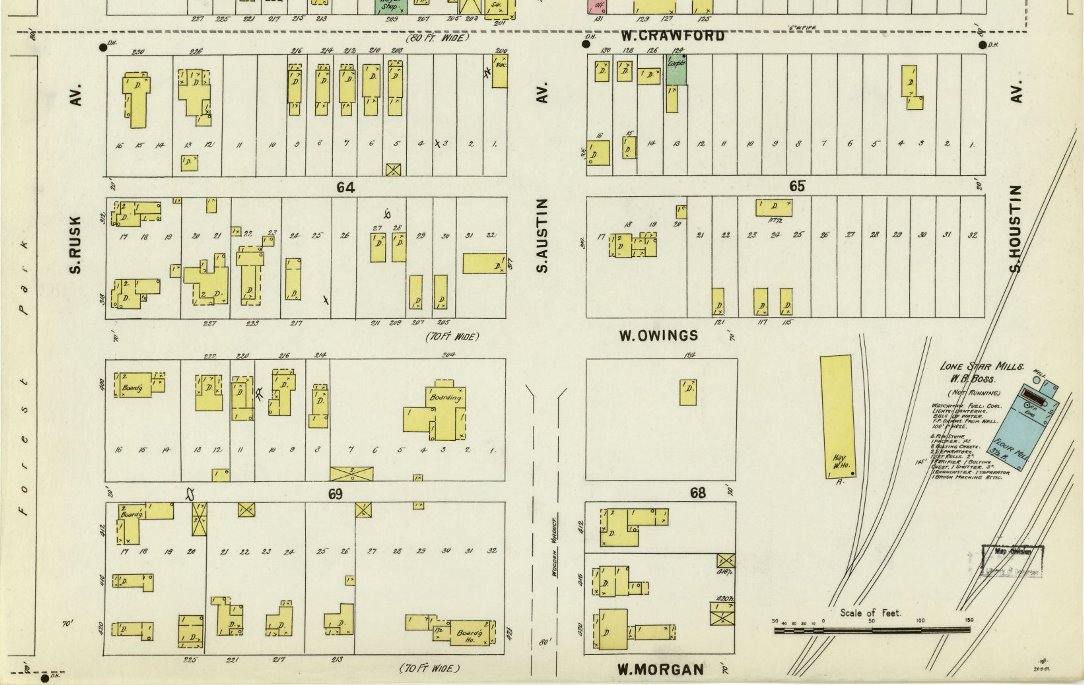
"The citizens of Denison gathered at the foot of Owings Street –
just where the foot of the street was remains a mystery – to witness
the laying of the cornerstone of what was called “the magnificent Flour
Mill” being built by Messrs. Boss, Jennings & Co. At the request of
the group gathered there, J.W. Jennings acted as master of ceremonies
and in a few brief remarks explained the nature of the occasion.
Workmen then laid the northeast cornerstone of what was described as
“the most expensive building yet projected in Denison.” After the stone
was placed, the “blessings of Deity were invoked on the proprietors,
the workmen and the building,” and congratulations from the crowd were
generously extended.
Sealed in a canister and placed under the
cornerstone were a copy of the first number of the Daily News, a copy
of the Weekly News, a copy of the Journal, a time card and freight
tariff of the Katy Railroad, one of Boss, Pinto & Jennings’
business cards, a postage stamp, a nickel, each denomination of
fractional currency, a letter of dedication and a small vial of the
fluid extract of corn."---Hunt, Donna, "Denison Has a Mill Town History", Denison Herald, January 4, 2015
The Daily Cairo (Illinois) Bulletin
August 5, 1880
pg. 1
A Bread Show
Denison, Tex., Aug. 3 - A novel but interesting exhibition took place
here this afternoon, vis., a bread s how. About 2 weeks ago the
Lone Star mill offered a prize of a barrel of flour to the lady baking
the best loaf of bread; and merchants and others offered additional
prizes. To-day being set for the contest J.W. Burson, editor of
the Herald; B.C. Murray, editor of the News,
and another gentleman, acting as judges, sampled a huge pile of the
"staff of life," awarded 9 prizes and are now hiding from about 200
unsuccessful competitors for that barrel.


Letterhead
for Boss, agent
Lone Star Flour Mill
September 14, 1881
Denison, Texas
The
early partnership with
Jennings and Pinto soon evaporated. According to City
Directories,
the Lone Star Mill was owned by Knapp & Stout. As early as
1876, William
Boss was listed in the City Directory as agent for Knapp, Stout, and
Company. Wikipedia
has a good deal to say about Knapp & Stout:
Knapp, Stout & Co. was a lumber company based in Menomonie, Wisconsin,
in the 19th and early 20th centuries. The company was established
in 1846, when John Holly Knapp and William Wilson purchased a lumber mill on the Red Cedar River
from David Black; it was originally known as Black & Knapp; it was
originally known as Black & Knapp. Henry Stout became an
owner of the company in 1853, and its name became Knapp, Stout &
Co. The company's location allowed it to control the lumber
industry in the region, and by 1870 it controlled the logging industry
in the Red Cedar River valley. In 1878, the company incorporated,
and its official name became the Knapp, Stout & Co. The
company employed over 2,000 workers in the Menomonie area and produced
85 million board feet
of lumber on average yearly from 1871 to 1896; its output made it the
largest lumber company in the world. In the 1880s, the company
expanded to sites along the Mississippi River, opening office in Dubuque, Iowa, Read's Landing, Minnesota,
and St. Louis Missouri. By the 1900s, the company had largely depleted
its lumber supply; it closed many of its camps and dissolved early in
the 20th century. The company sent out its last shipment of lumber on
August 12, 1901.
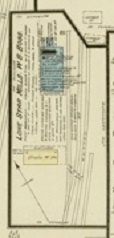
Lone
Star Mill
Detail, 1885 Sanborn's Map for Denison, Texas
Boss and his wife Margaret lived
on the southwest corner of Day Street and Lamar Avenue. Both had been
married
previously. They had two children, possibly from previous
marriages—William F.
Boss (1862–?) and Lillian C. Blood Brown (1866–1924). Lillian in 1889
married
Henry Wiltz Brown, who became a longtime newspaper editor in Findley,
Hamilton
County, Ohio.
The property was clearly depicted
on the 1886
"Bird's-Eye Map" drawn by Henry Wellge.
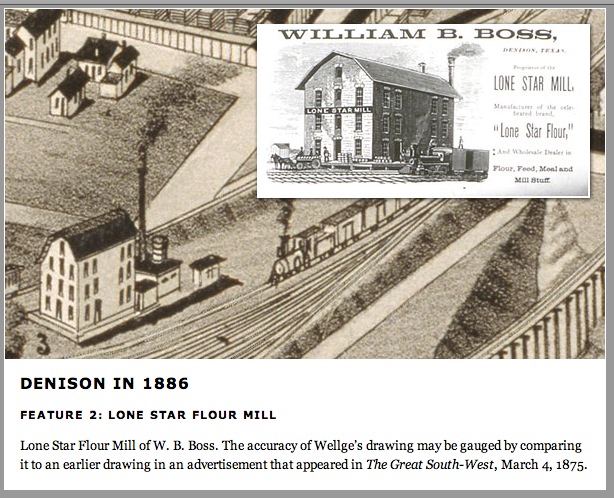
Lone
Star Flour Mill, 1886
William B.
Boss
Source:
1886 Bird's Eye Map
Henry
Wellge (1850–1917). Denison, Texas. Grayson County. 1886, 1885. Toned
lithograph, 17.6 x 26.9 in., by Beck & Pauli, Milwaukee.
(Published by Norris, Wellge, & Co., No. 107 Wells St.,
Milwaukee, Wis.). Amon Carter Museum, Fort Worth.
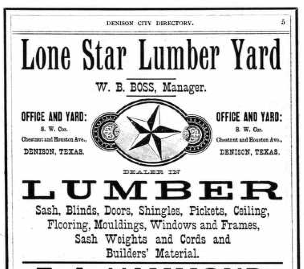
Lone Star
Lumber Yard advertisement
1887 Denison City Directory
The
1891 City Directory listed
both the Lone Star Lumber Yard, with both yard and office at the
southwest
corner of Chestnut Street and South Houston Avenue; and the Lone Star
Flour
Mills at the corner of South Houston Avenue and Owings Street. That
year
William was listed as "Manager, Lone Star Lumber Yard, lumber, laths,
shingles, sash, doors, blinds ... Rooms at Howard E. Hanna, boards with
Mrs. M.
V. Cummings." William's wife was listed separately, which was rather
unusual: "Mrs. W. B. Boss, proprietress, Lone Star Lumber Yard ...
boards
at Mrs. M. V. Cummings." The Lone Star Flour Mills were owned by Knapp,
Stout, & Company of St. Louis, Missouri.
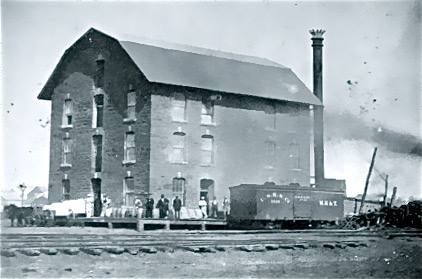
pre-1886
A MK&T railway car made by C.S.R.S. Co. on the tracks in front of the building,
The men standing on the walkway/loading ramp around the building are possibly employees of the mill.
The building was demolished in early 1906
By
1896 the Bosses had left
Denison, perhaps reflecting the decline of Knapp & Stout. The
Census of
1910 found William working as a commercial traveler selling lumber. He
and wife
Margaret A. were living in Sedalia, Missouri, a major stop on the
MK&T
Railway between St. Louis and Denison. The next year, they had moved to
Findley, Ohio, where daughter Lillian lived; William was still working
as a
commercial traveler. By 1914, the Findley City Directory listed no
occupation
for him. In 1911 Mrs. Boss renewed her subscription to her old hometown of Denison.
In B. C. Murray's Little Story No. 25, published in 1910, he wrote, "The old mill was acquired by the MK&T many years ago and
dismantled." The clippings below show that what seemed like many years to Murray was actually only four or five. The Katy acquired the decaying mill in 1905 and finished demolishing it a year later. Some materials from the mill were recycled locally (as was the lumber from the old canning factory). The stones from the walls are probably still present in some bridge abutments around Denison.
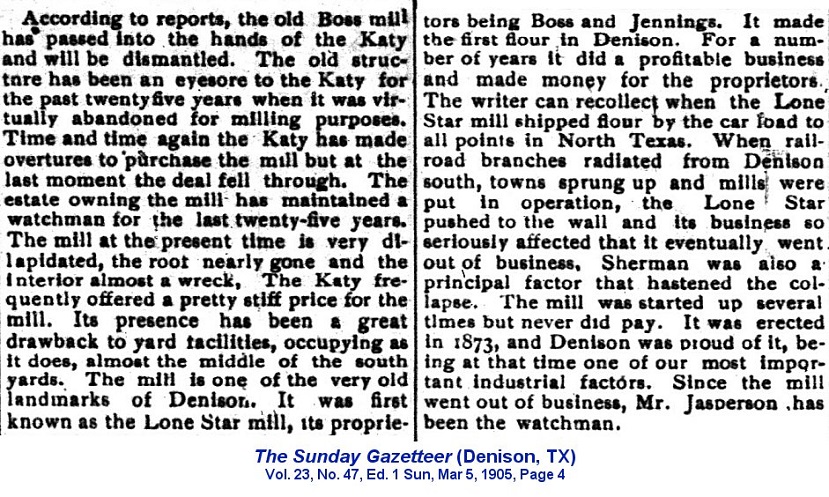
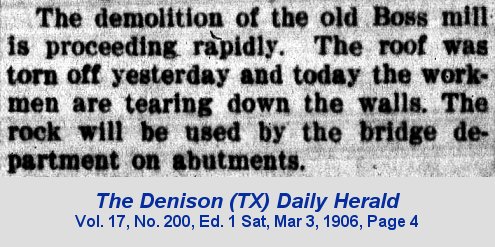
Much discussion was made in the newspapers about the whereabouts of the cornerstone set in place in 1873.
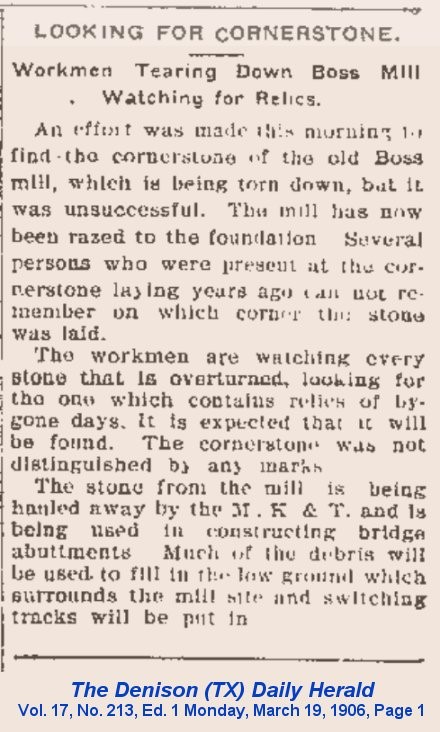
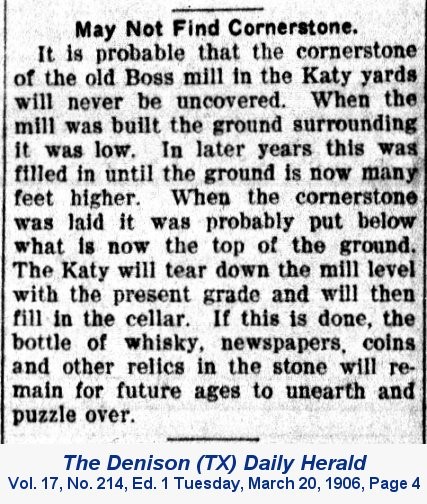
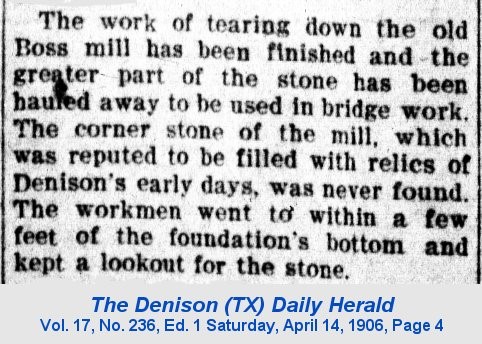

The Sunday Gazetteer
Sunday, April 23, 1911
pg. 4
When an old-timer leaves Denison the Gazetteer is almost sure to follow them. This reminder is called by the renewal of the subscription of Mrs. W.B. Boss, so well and favorably known in pioneer society circles. Mrs. Boss is at present at Findlay, Ohio. The old Boss residence in southeast Denison was the most noted social center in Denison in the early period.
Mrs. Boss was a beautiful, stately lady and a royal entertainer. She was assisted by her daughter, Miss Lillian, a very beautiful and accomplished girl, who turned the hearts of many young men. Among the saddest memories is that the good old times are gone; but they were the most pleasant that Deniion ever experienced.
Margaret died in
1914. In 1921, William was a widower living in Woodstock, Illinois. He
died
that year in Chicago and was buried in Findlay, Ohio alongside of Margaret.
